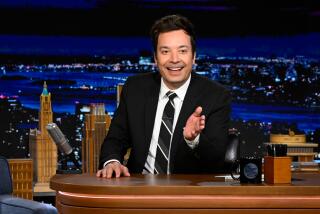Macchio Succeeds Nicely in ‘Business’
Yes, Ralph Macchio can play a canny corporate climber with the best of them in “How to Succeed in Business Without Really Trying.”
That answers the biggest question hanging over this touring production of the Frank Loesser-Abe Burrows musical, now at the Pantages Theatre before moving to the Orange County Performing Arts Center and McCallum Theatre.
After the success of Des McAnuff’s staging in La Jolla and on Broadway, the production could be expected to dazzle and amuse. Still, Macchio has no track record as a musical comedy star.
Of course Matthew Broderick didn’t either when he took the same role and went on to win a Tony in this production. And Macchio, it turns out, studied dance in his youth.
The dancing is important here. Not that young J. Pierrepont Finch has to be a Baryshnikov. But he does have to wriggle out of tight situations with physical elan, and Macchio makes the right moves.
Macchio’s singing voice isn’t as smooth as his movements, but its untutored quality (which may, in fact, be carefully tutored) is right for this role. Although Macchio is 34, his voice sounds as if it changed about a year ago, matching his guileless features. This “eagerest beaver of them all” seems so young that we can imagine why his rivals would first underestimate him and then become bitterly jealous over his rapid rise through the ranks of World Wide Wicket Company.
The rest of the casting is equally on target. Roger Bart, with a Peter Sellars haircut and a gleeful grin, is wickedly funny as Finch’s nemesis Bud Frump. Richard Thomsen is a lean, reedy J.B. Biggley, with a scowl and a harrumph that mean business--until we see him alone with his knitting or with Pamela Blair’s “bubble-headed tomato,” to use an apt description of his tootsie.
John Deyle’s Bert Bratt, director of personnel, looks remarkably like Pat Buchanan. This probably wasn’t intentional, for Bratt is a toadying yes-man--a quality that Buchanan can hardly claim--but it does indicate how each shift in the corporate winds can register so strongly on his face. Shauna Hicks, as the much-ignored secretary who nevertheless dotes on Finch, seems like such a nice kid that you wish, from a ‘90s perspective, that someone would shake some sense into her.
*
The program states clearly that the show is still set in 1961--which is reflected in the gender roles and Susan Hilferty’s costumes. Yet much of the design has a brilliant ‘90s look. McAnuff is surely inviting us to compare the corporate gamesmanship back then to what’s happening now.
The loyalty expressed in the song “The Company Way” sounds almost cult-like in a downsized age--and maybe the suggestions of stained glass lighting near the beginning of the show are meant to imply a religious devotion. Of course the thrust of the show was always to expose and mock the hollowness of this corporate faith.
The ‘90s imagery--as seen primarily in a giant screen at the back of the stage that whisks us up and down the elevators and around the skyscrapers and out to New Rochelle as if we were playing some particularly entrancing CD-ROM--doesn’t add much substance to the script’s original critique, but it does remind us that technology has changed the playing field. “A Secretary Is Not a Toy” now sounds antique not only because of attitudes toward sex roles but also because so many secretarial duties have been computerized.
Wayne Cilento’s choreography (as in the hilarious “Coffee Break”) has a lot of jagged edges and frantic huddling. It’s almost as if the cast is squeezed onto the stage under the looming cybervision at the back. This shrewdly signifies the increasing pressure on human beings as they struggle to survive in the corporate jungle in 1996 as well as in 1961.
In fact, the script could be converted into an interesting CD-ROM--click here and Finch will advance closer to the brass ring! Nevertheless, it’s more fun to see all this with real people on a big stage, where we can huddle with our fellow bread-earners for a few hours, laugh at our common plight and indulge in a few fond notions about “The Brotherhood of Man.”
* “How to Succeed in Business Without Really Trying,” Pantages Theatre, 6233 Hollywood Blvd. Tuesdays-Saturdays, 8 p.m.; Sundays, 7 p.m.; Saturdays-Sundays, 2 p.m. Ends Sept. 29. $22-$48. (213) 365-3500. Also at Orange County Performing Arts Center, Costa Mesa, Oct. 29-Nov. 3, and McCallum Theatre, Palm Desert, Dec. 10-15. Running time: 2 hours, 45 minutes.
(BEGIN TEXT OF INFOBOX / INFOGRAPHIC)
Ralph Macchio: J. Pierrepont Finch
Roger Bart: Bud Frump
Richard Thomsen: J.B. Biggley
Shauna Hicks: Rosemary Pilkington
John Deyle: Bert Bratt
Pamela Blair: Hedy La Rue
Michael Cone: Twimble/Wally Womper
Susann Fletcher: Smitty
Tina Fabrique: Miss Jones
Clif Thorn: Milt Gatch/Toynbee
Christopher Mixon: Ovington/Office Boy/Johnson/TV Announcer
Produced by Dodger Productions, Kennedy Center for the Performing Arts. Music and lyrics by Frank Loesser. Book by Abe Burrows, Jack Weinstock and Willie Gilbert. Based on Shepherd Mead’s book. Directed by Des McAnuff. Choreographed by Wayne Cilento. Sets by John Arnone. Lights by Howell Binkley. Costumes by Susan Hilferty. Video by Batwin + Robin Productions. Sound by Steve Canyon Kennedy. Hair by David H. Lawrence. Orchestrations by Danny Troob, David Siegel, Robert Ginzler. Musical supervision and vocal arrangements by Ted Sperling. Musical director Randy Booth. Dance arrangements by Jeanine Tesori. Production stage manager Susan Green.
More to Read
The biggest entertainment stories
Get our big stories about Hollywood, film, television, music, arts, culture and more right in your inbox as soon as they publish.
You may occasionally receive promotional content from the Los Angeles Times.






